Traditional Panettone Recipe (Italian Christmas Cake)
Updated Mar 01, 2025, Published Dec 03, 2022
This post may contain affiliate links. Please read our disclosure policy.
Traditional Panettone Recipe (Italian Christmas Cake) consists of a tender lemon and orange-scented sweet dough studded with candied fruit and raisins. You will want to devour this buttery bread for every special occasion! This detailed post with step-by-step photos makes this panettone recipe achievable.
You’ll also love our traditional Italian Christmas Recipes.
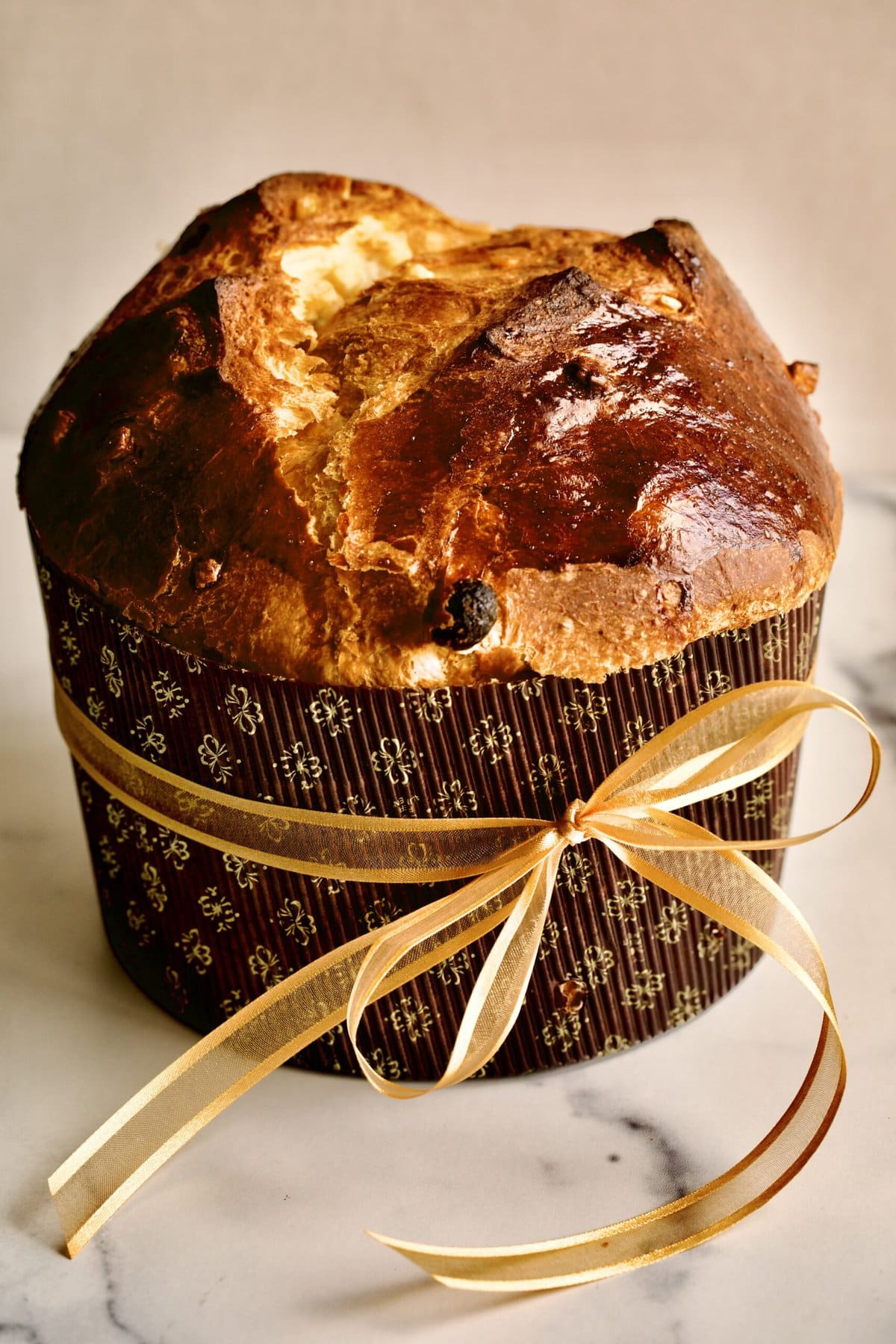
This traditional panettone recipe comes straight from Italy! This classic recipe is adapted from my great nonna Pierina’s. It resembles our Italian Brioche Bread Recipe (Soft and Easy) Italian Sweet Braided Easter Bread, and my pear cake recipe.
What is Panettone?
Panettone is a sweet, soft, and buttery bread similar to brioche. It is loaded with lemon and orange zest, candied orange peel, raisins, and spices and baked in a paper mold to give it a tall and unique shape.
This panettone cake recipe is a sweet bread baked in a round pan or mold, giving it a lighter-than-air fluffy texture. You can vary the filling if you don’t like candied fruit or raisins. You can call it a “fruit cake,” but I don’t like those, ha!
We call it Italian Christmas bread since it is traditionally baked during the holiday season and shared with friends and family. Pair it with our Best Christmas Desserts to complete your holiday table menu!
Serve with Authentic Thick Italian Hot Chocolate, Cranberry Orange Bread, or The Best Homemade Chocolate Syrup Recipe.
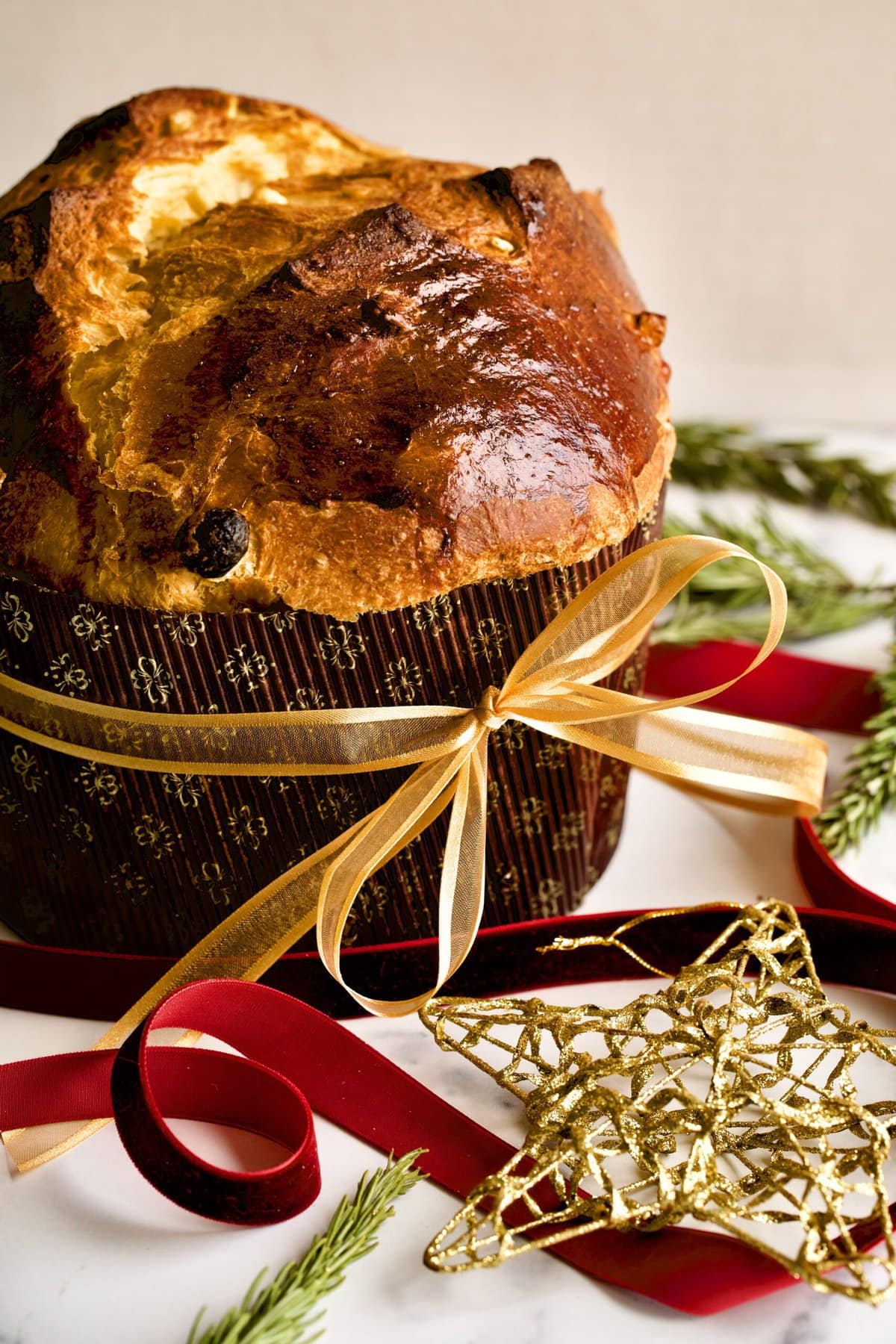
Every Italian bakery has this sweet bread recipe during the holiday season. While traditionally served for Christmas, this sweet bread is also popular in the New Year.
Since my mamma’s birthday is at the end of December when she was growing up in Italy, this panettone recipe was her birthday cake! How would you like to have sweet Christmas bread as your birthday cake? As a child, she wasn’t always a fan, but she adores the tradition we still keep today.
Table of Contents
- What is Panettone?
- Simple Ingredients
- How To Make Panettone
- How to Fold the Panettone Dough
- Top Tips
- Panettone Recipe FAQ
- Variations
- Equipment
- Serving Suggestions
- How to Store Italian Christmas Cake
- What to do with Leftover Panettone
- History of Traditional Panettone- Italian Christmas Cake
- Panettone Recipe
Simple Ingredients
Homemade panettone is 100% worth the effort. The ingredients are simple, and you can easily find all candied and dried fruit this time of year.
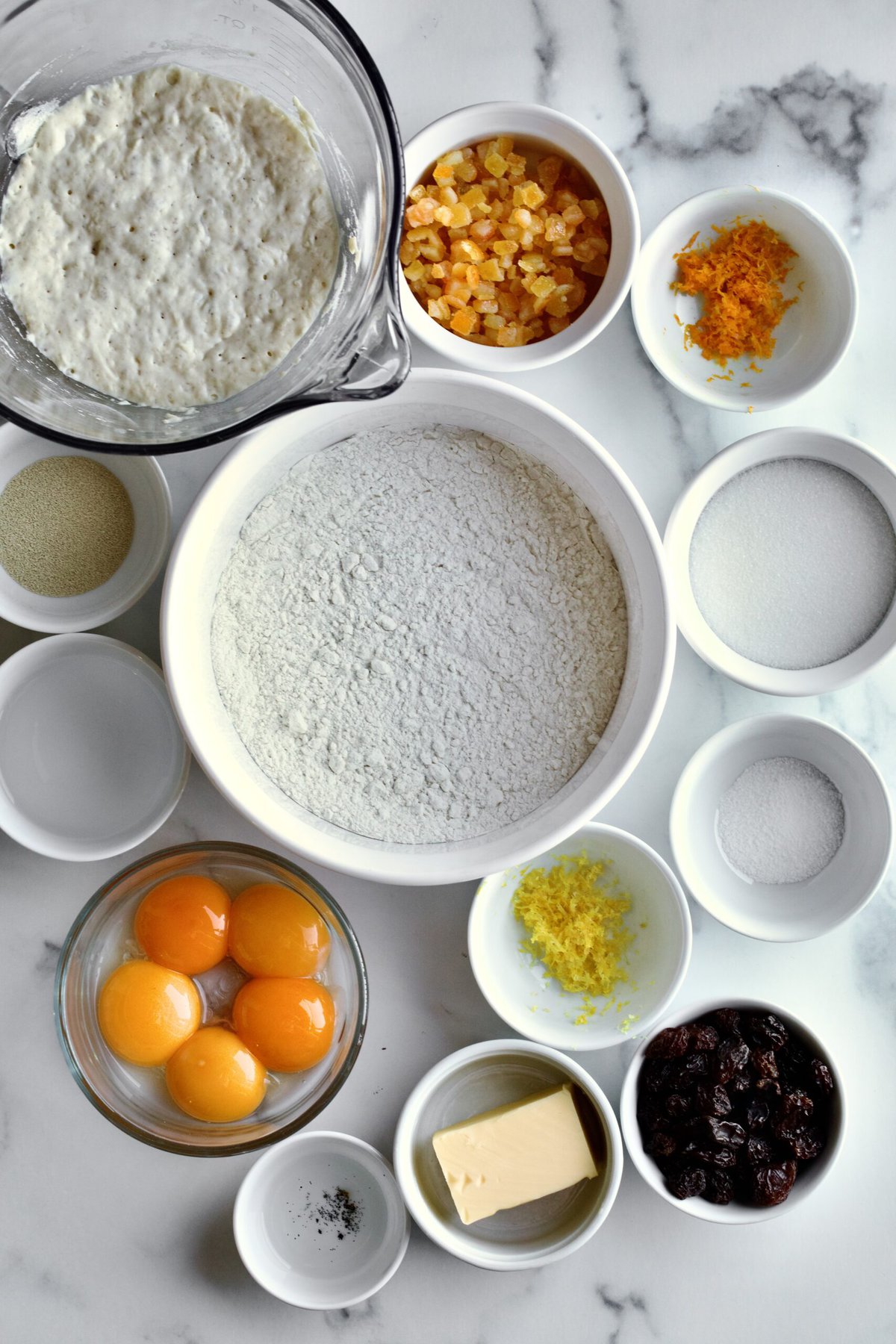
FOR THE DOUGH STARTER
Biga (this is a type of pre-fermentation used in Italian baking). If you have a sourdough starter on hand, you can replace it with that.
- All-purpose flour
- Instant yeast
- Cool water
FOR THE DOUGH
- All of the dough starter (above)
- Grated zest of lemon
- Grated zest of orange
- Honey
- Butter
- Granulated sugar
- Eggs
- Vanilla extract
- Bread flour
- Salt
- Water
- Instant yeast
MIX-INS (see notes for variations)
- raisins
- candied orange peel
TOPPING
- 1 egg, beaten for egg wash
- Pearl sugar (optional)
- A small pat of butter
See the recipe card for quantities.
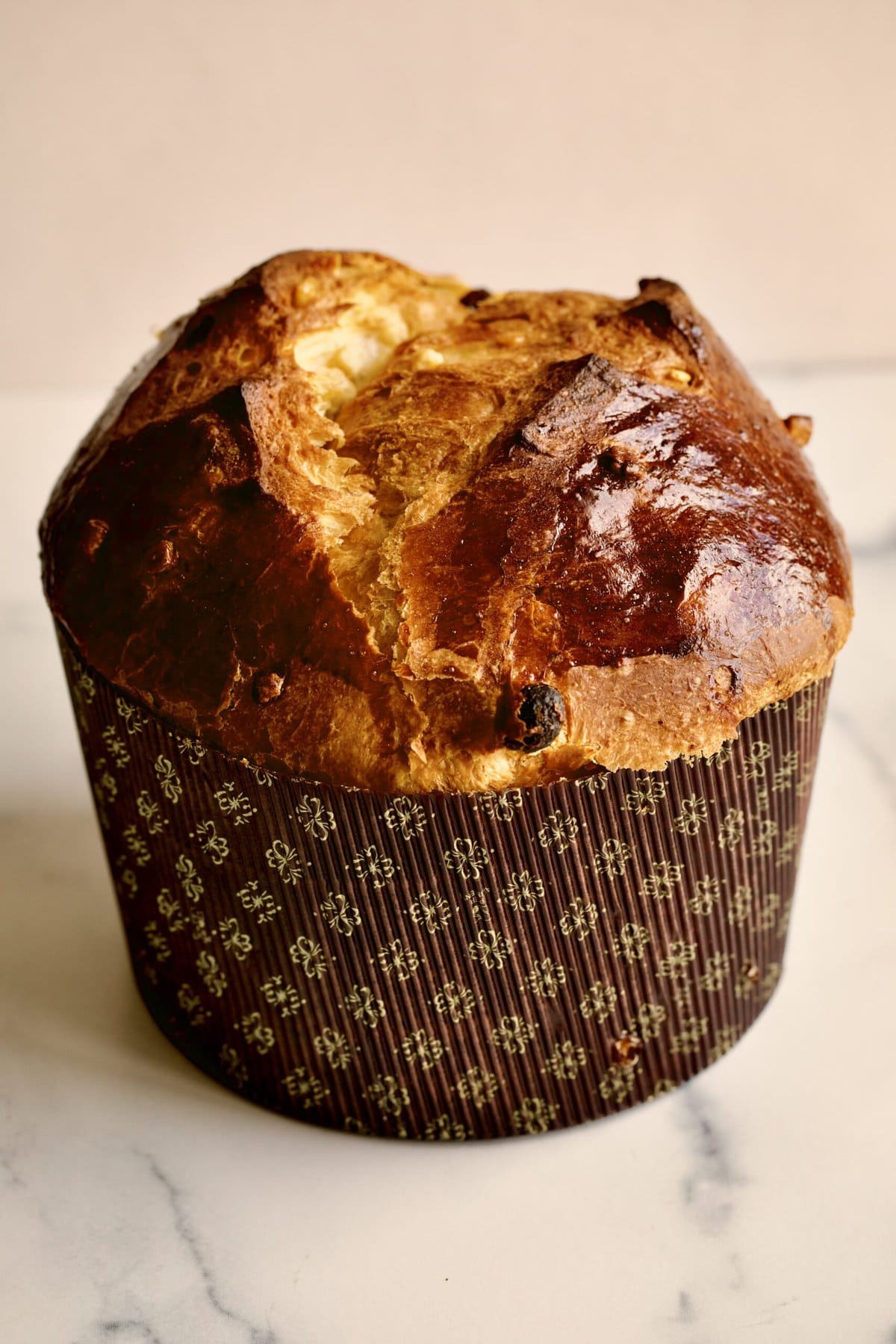
How To Make Panettone
This is the PERFECT way to make Traditional Italian panettone. For this recipe, using a kitchen scale and measuring your ingredients is important. All you need is a bit of patience for the dough to rise at different stages. You start the dough starter (biga or lievito madre) the night before; the rest is all done in ONE DAY!
The Night Before Baking
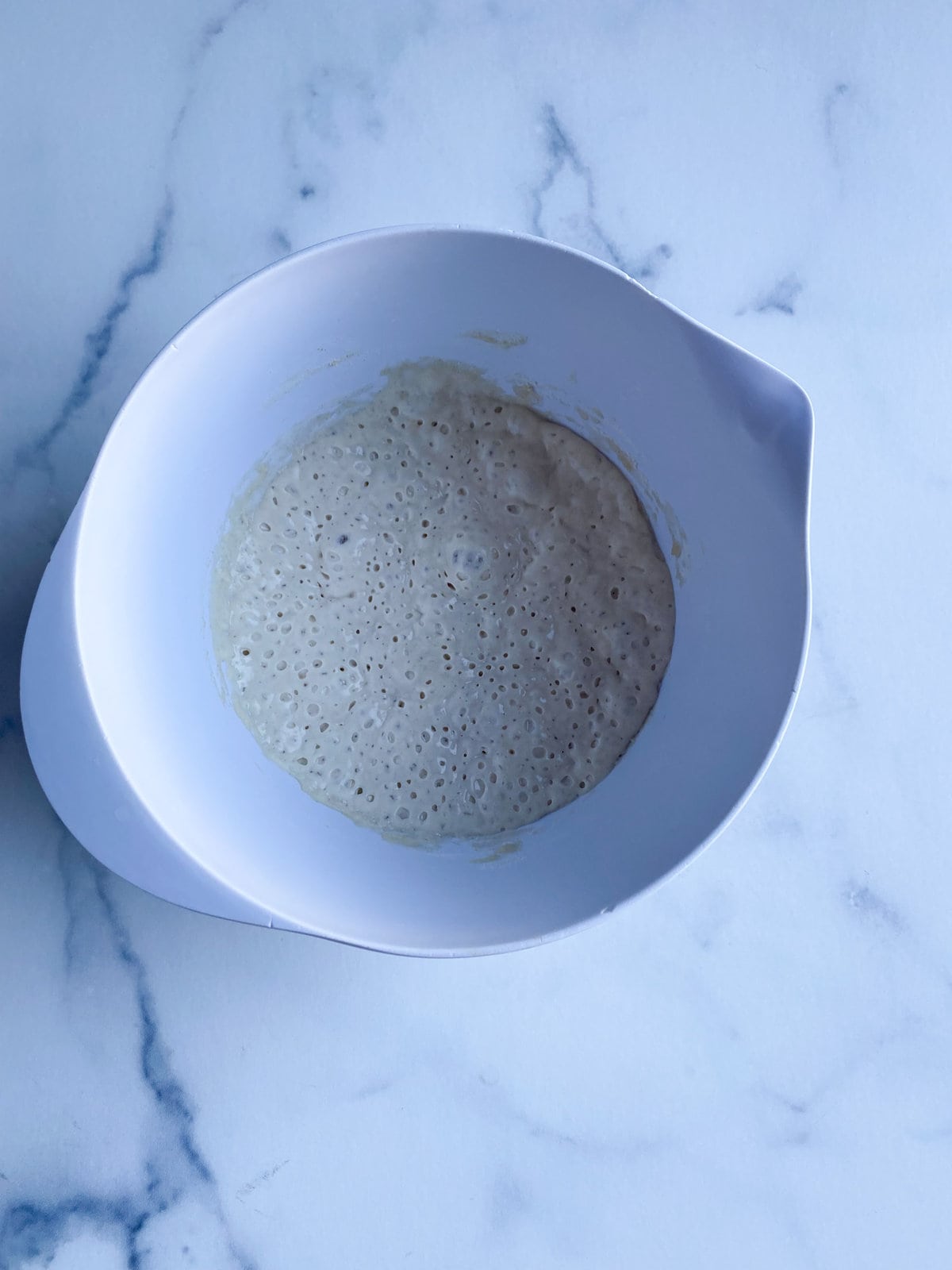
Dough Starter: (photo of dough starter AFTER overnight rise) Combine the starter ingredients in a medium-sized mixing bowl, and mix with a fork until a shaggy mixture. Cover, and allow it to rest in a warm place for 8-12 hours. This is called your biga- a type of pre-fermentation.
NOTE: You can also use a sourdough starter if you have some and skip this step (use 190 g of the starter if you have it already).
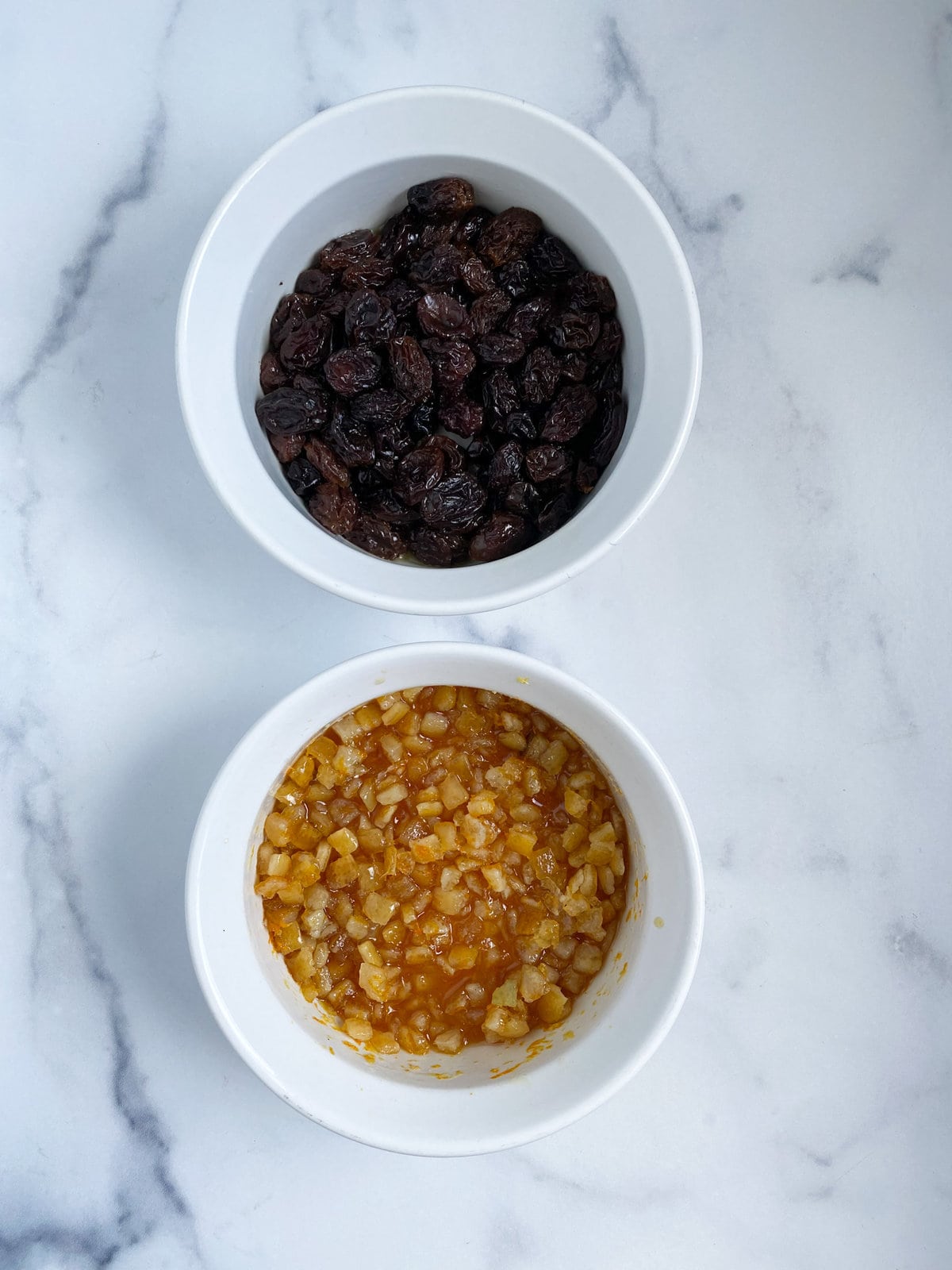
Prepare Mix-Ins: In a small bowl, combine the honey, vanilla extract, orange peel, and lemon + orange zest. Mix to combine. Cover and set aside. In a separate bowl, combine raisins with water. Cover and set aside. This step makes sure the raisins stay moist during baking. Let them rest overnight.
Baking Day

Dough Part 1 and 1st rise: in a stand mixer with a dough hook, combine the dough starter (biga), half of the flour, and all of the water and yeast. Mix until combined, and knead with the dough hook (or by hand) for about 5 minutes. Cover with plastic wrap and let rise for 1 hour in a warm place. The dough should triple in size.
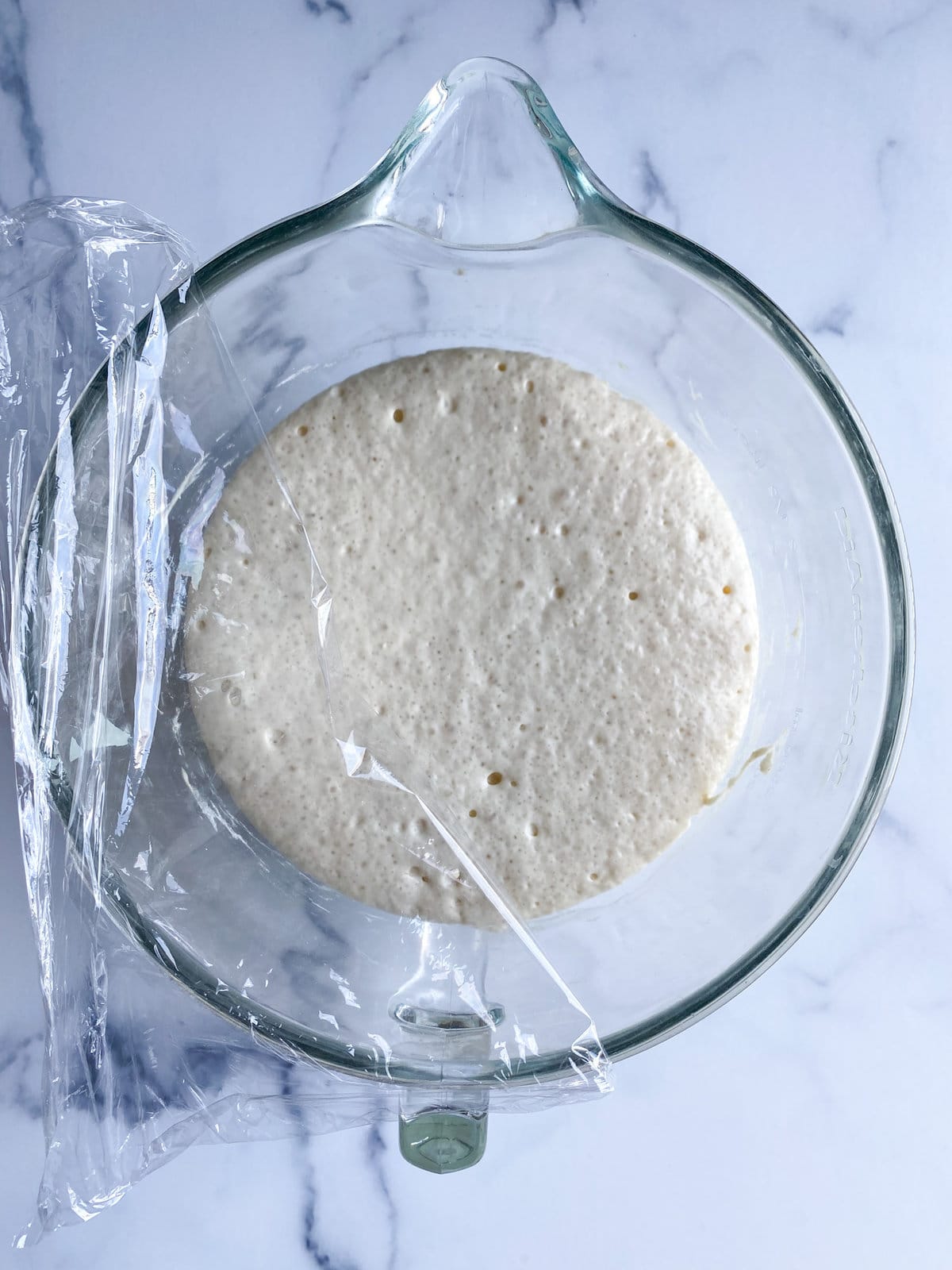
Dough Part 2 (photo of dough after rise): After the dough rises for 1 hr, add the rest of the flour and mix to combine.

After adding the remaining flour, the dough will look shaggy and crumbly. Let rest for 10 minutes.

Meanwhile, beat the egg yolks, salt, and sugar in a medium bowl until fluffy and creamy, about 5 minutes. Add the honey, candied orange, and zest mixture to the egg mixture.
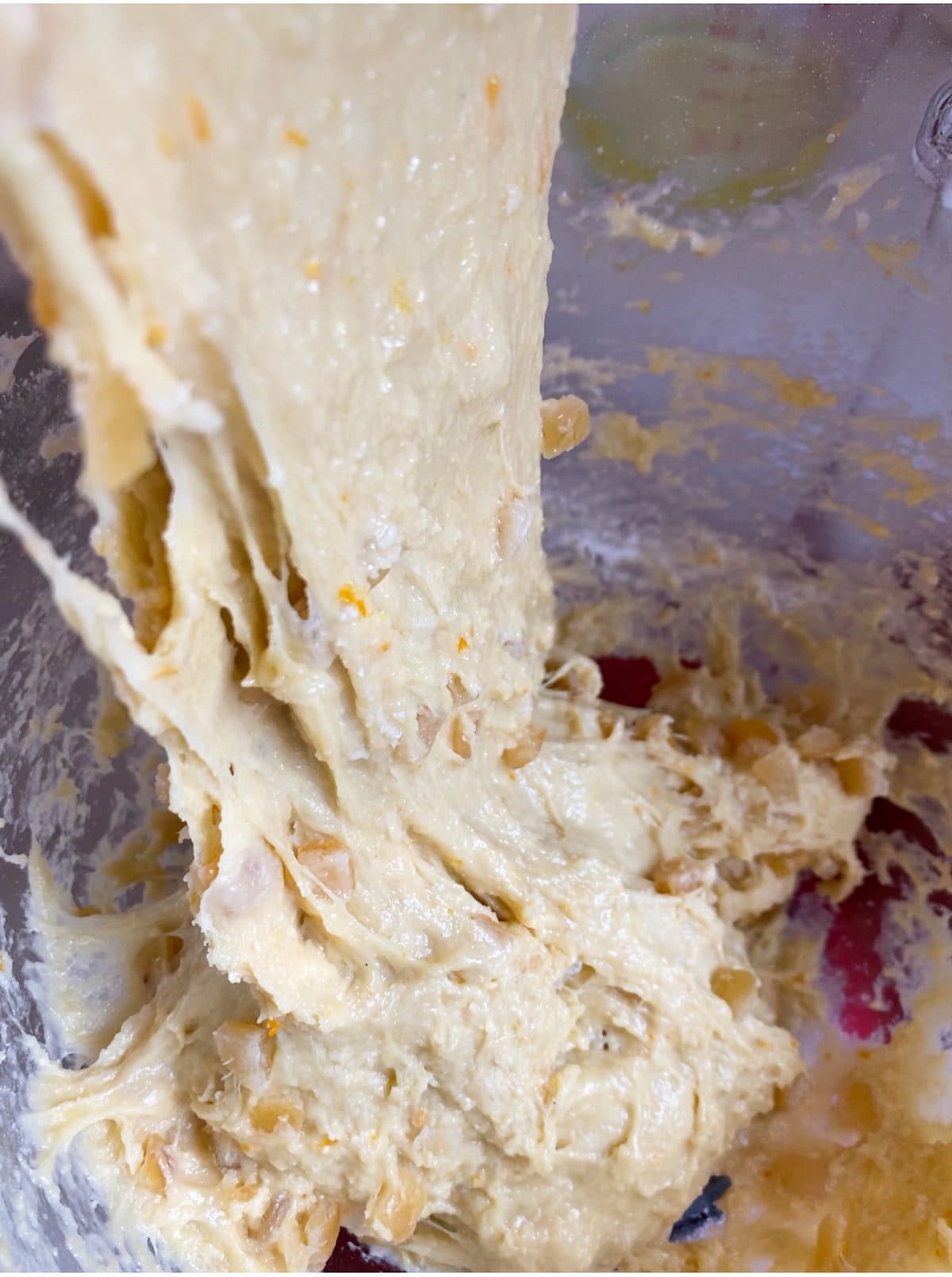
Slowly add the egg, sugar, honey, and zest mixture to the dough.
Beat until sticky dough forms; mix with a dough hook (or by hand) for about 5 minutes. The dough will be sticky! If the dough is too wet and not coming together, add a bit of flour.
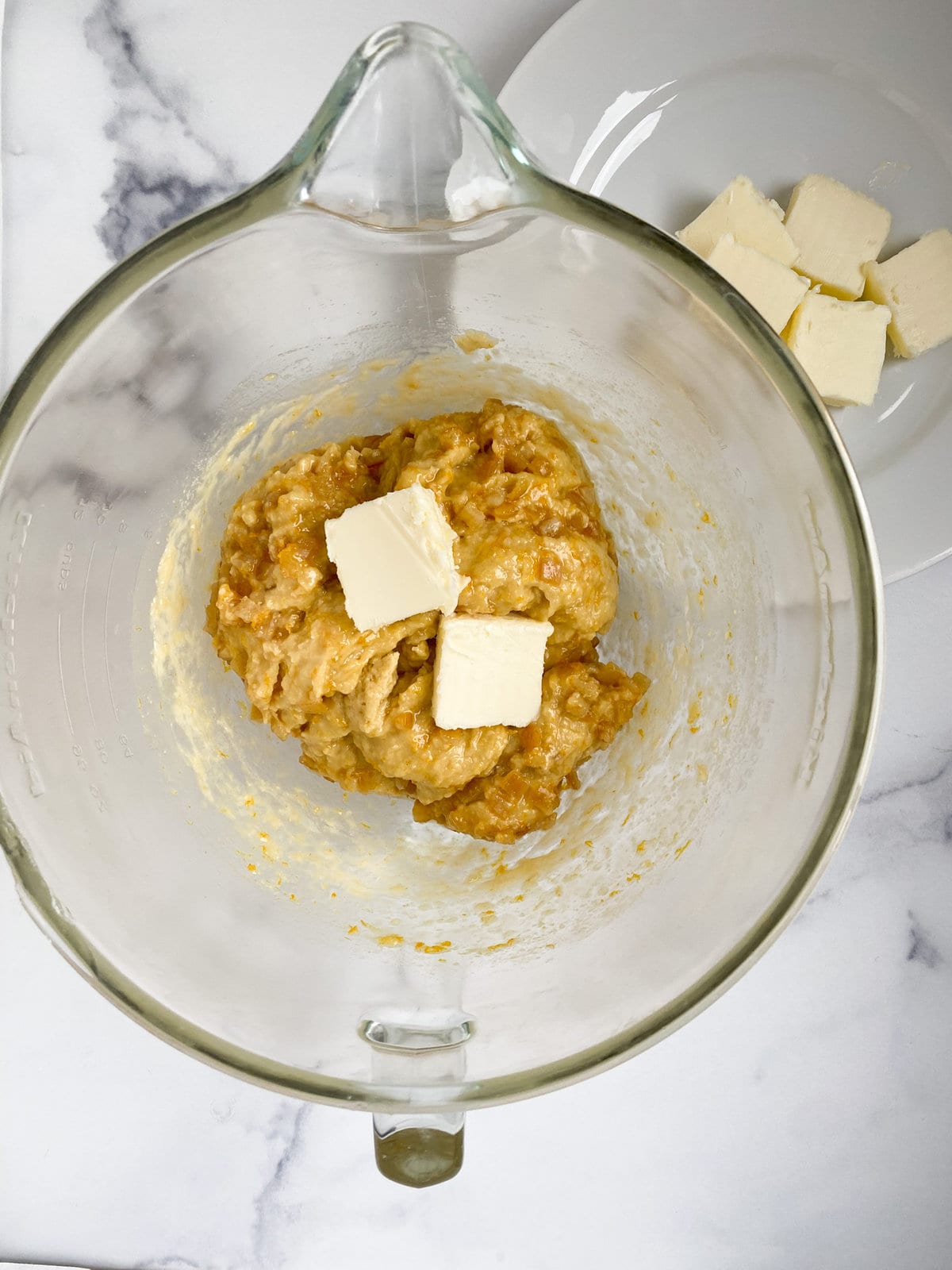
Add the butter to the dough, small bits at a time, mixing after each addition.
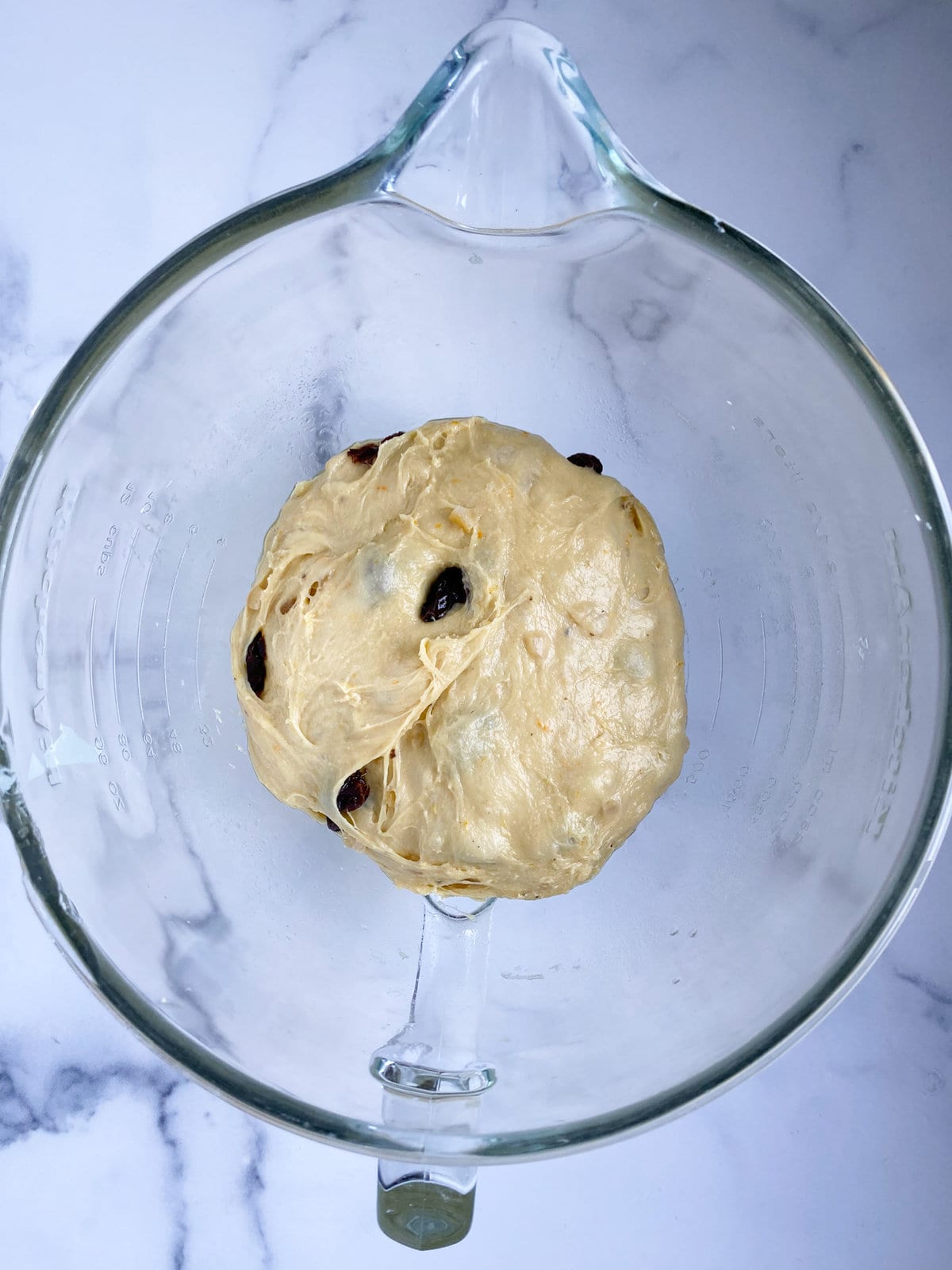
After the butter is incorporated, add the raisins (remove excess water, if any). Gently mix until the raisins are incorporated into the dough. Move the dough to a clean and greased bowl.
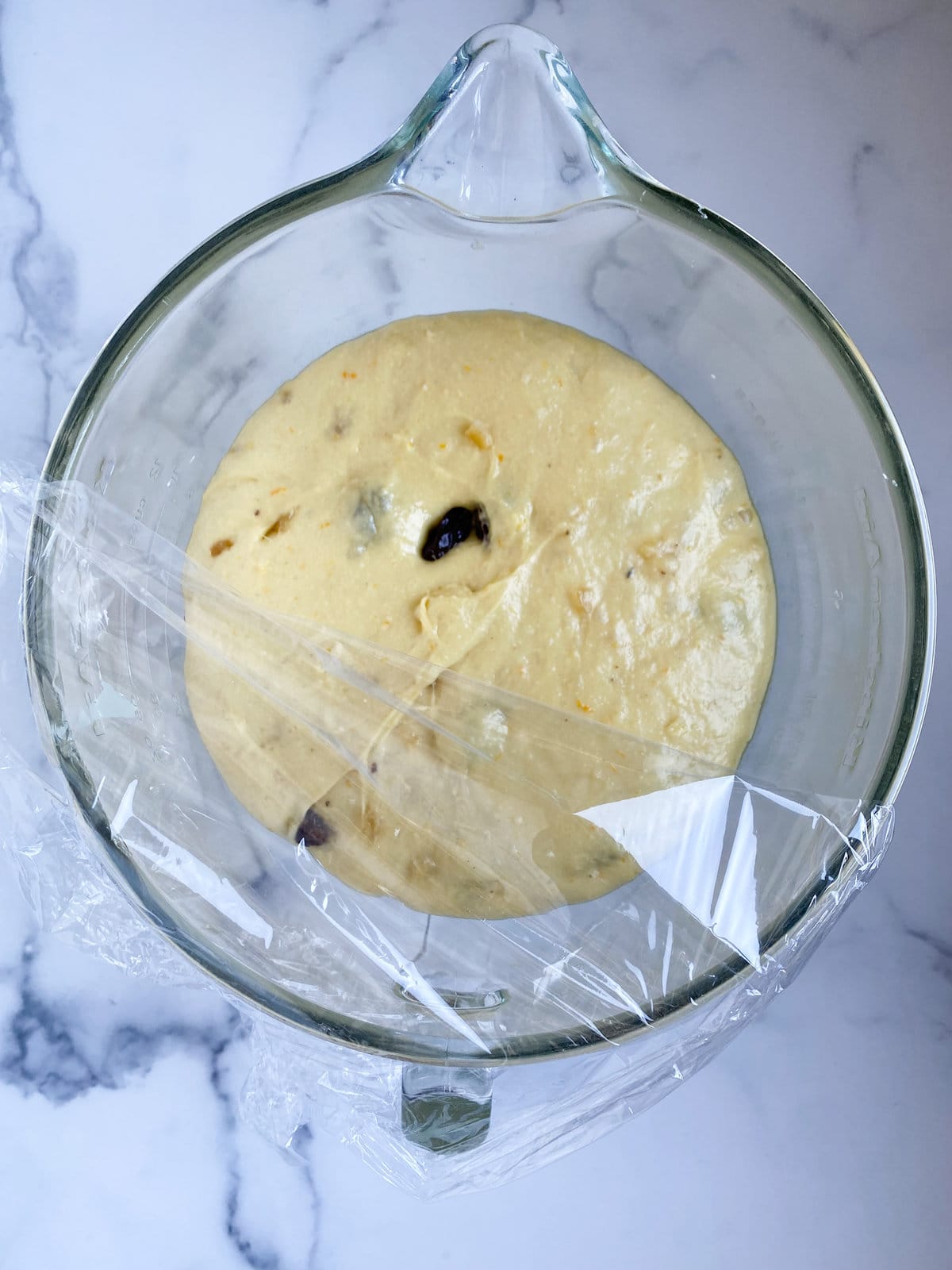
Dough Rise 2. Cover the dough, and let it rise for 1 to 1 1/2 hours, or until it’s puffy or proofed and doubled in size. Gently deflate the dough.
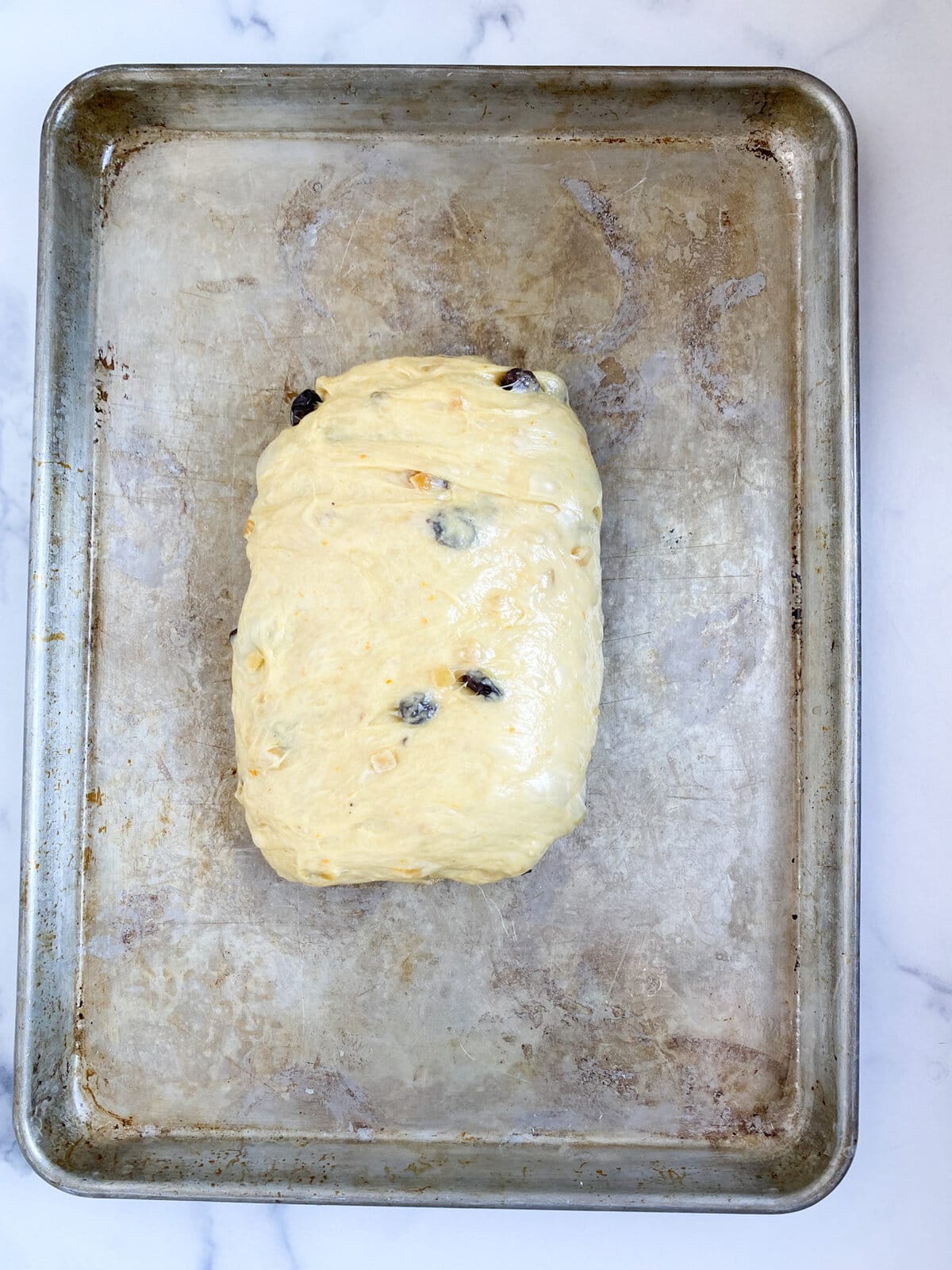
Fold Dough (see video below for more). Move to a greased baking sheet or countertop (do not add extra flour use greased hands to work with dough). Start clockwise- by taking the top corner of the dough (12 o’clock position), pinch a corner of the dough and lift it and let the dough stretch by lifting your hands. Fold the stretched dough back on itself (6 pm location). Turn the dough clockwise (your 12 o’clock position is now the 3 pm location). Repeat the same process of stretching and folding the dough onto itself three times total. This is a fast process that takes about 1 minute from start to finish.
Let the dough rest for 10-15 minutes and repeat the folding process 2 more times with these exact directions of stretching and folding.
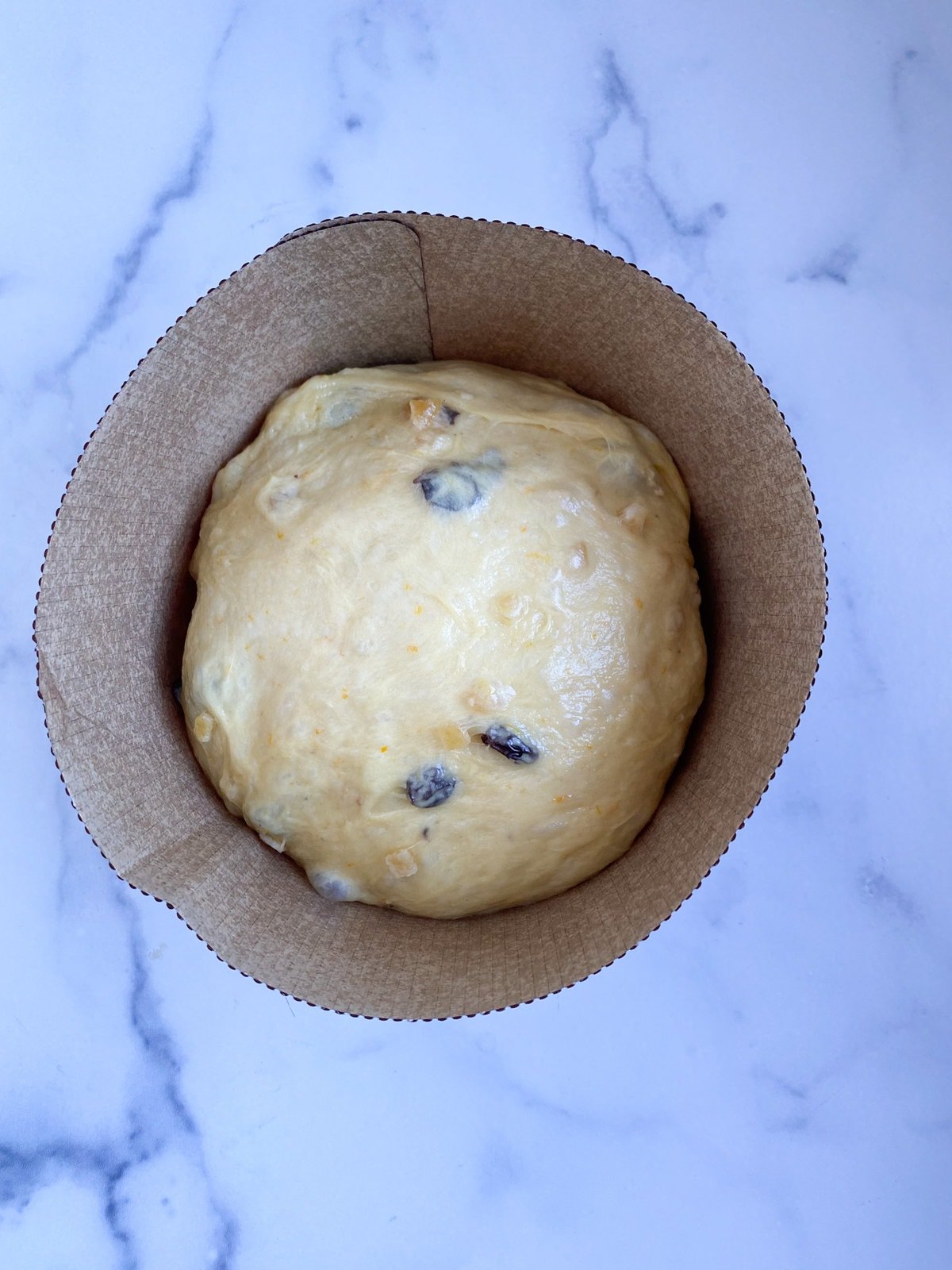
Shape Dough. Bring the corners toward the center to form a ball, and pinch the loose ends together. Cup your hands around the dough to round the ball. Place it in a well-buttered or sprayed panettone pan, mold paper, or other straight-sided, tall 1 1/2- to 2-quart pan.
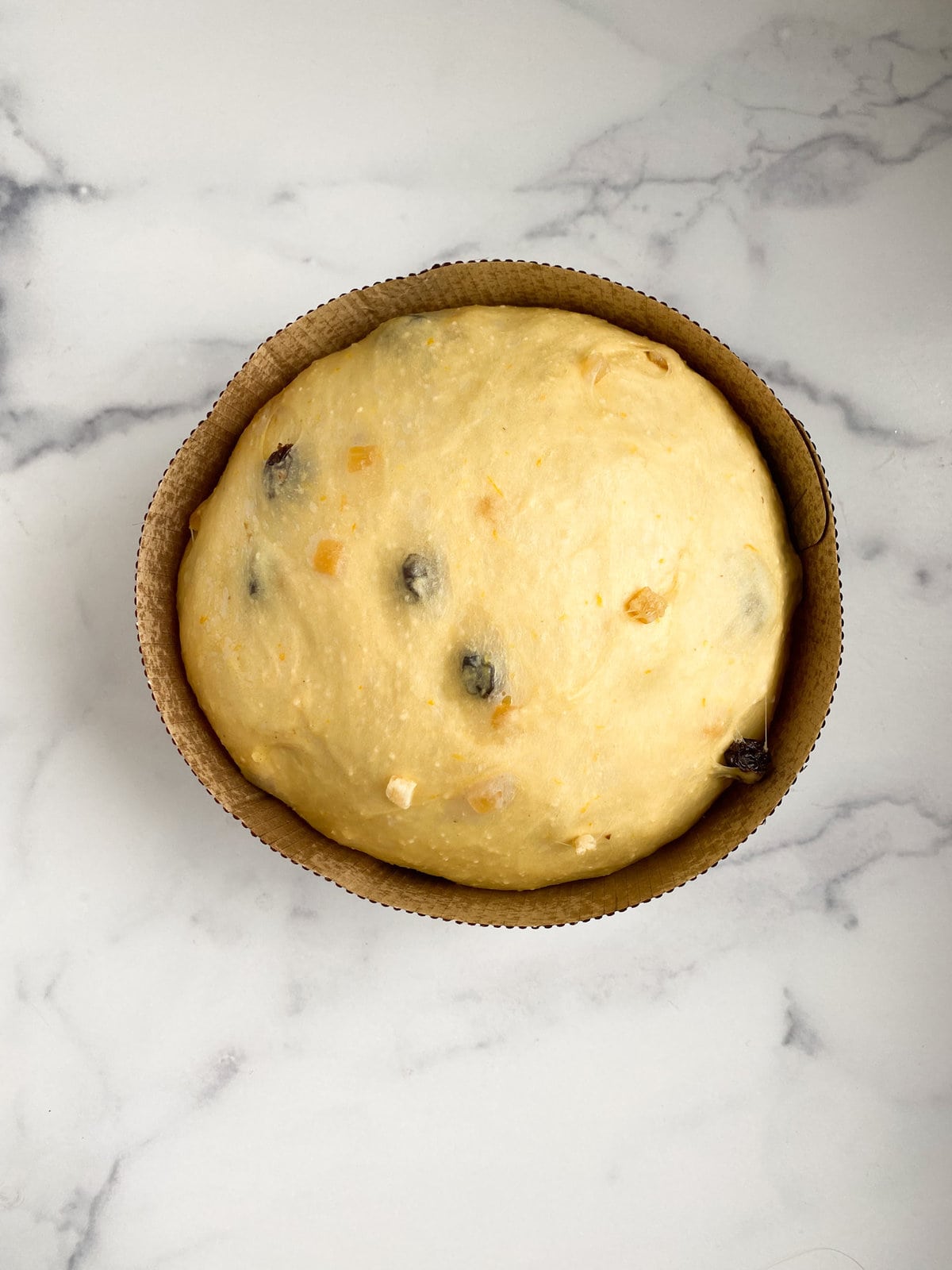
Dough Rise 3. Let the dough rise in a warm place until it reaches over the rim of the mold, about 1 1/2- 2 hours (time varies depending on humidity and temperature). You want the dough just at the rim or slightly above the mold.
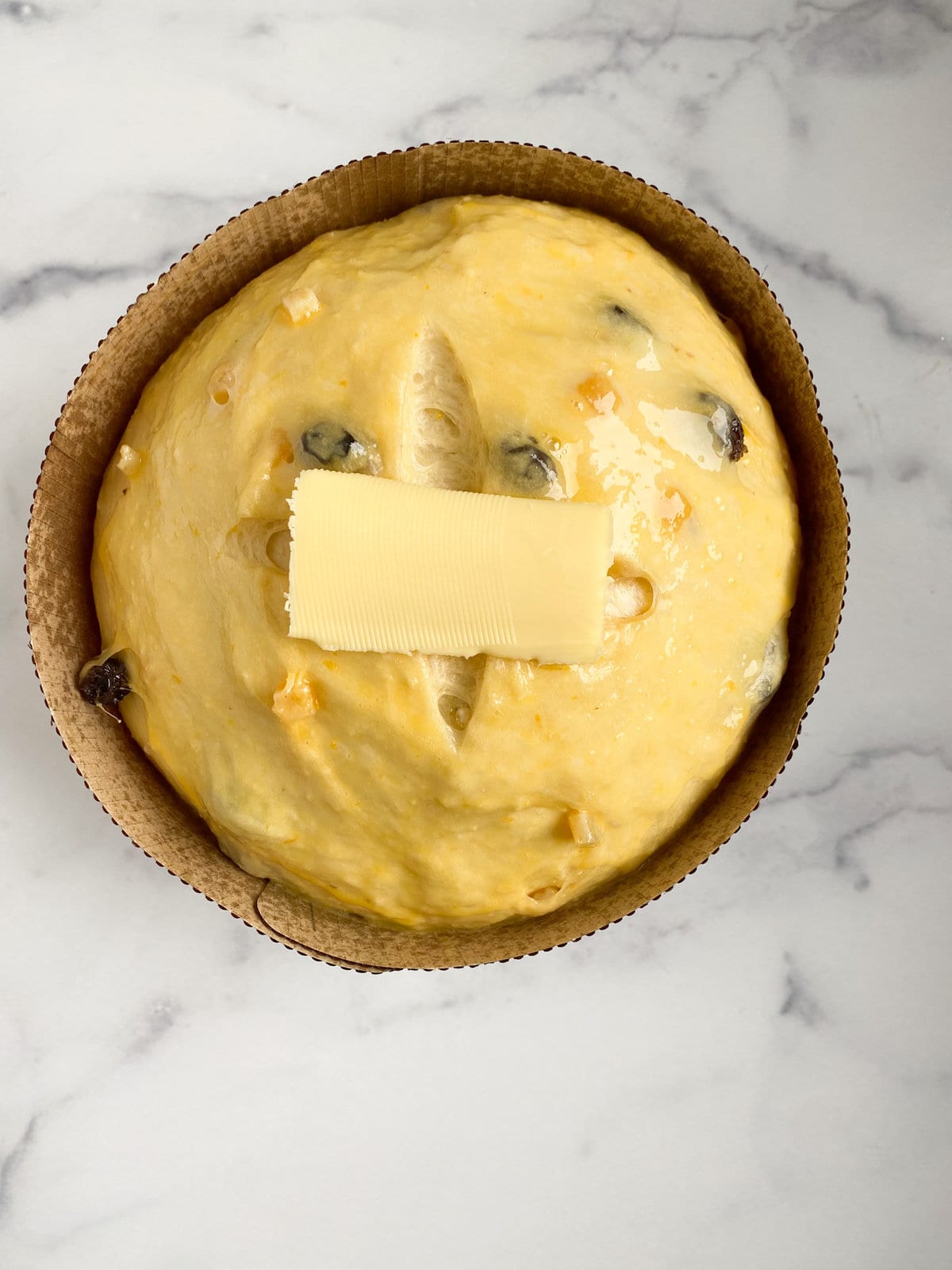
When the rise is complete, brush the top with egg wash. Make cross cuts on the panettone with a sharp knife, and put a small pat of butter in the center of the cake. Sprinkle with the desired amount of pearl sugar (optional).
Bake. Bake the cake in a preheated 375°F oven for 10 minutes; then reduce the heat to 350°F and bake for about 40 minutes, tenting with aluminum foil if the top of the panettone appears to be browning too fast.
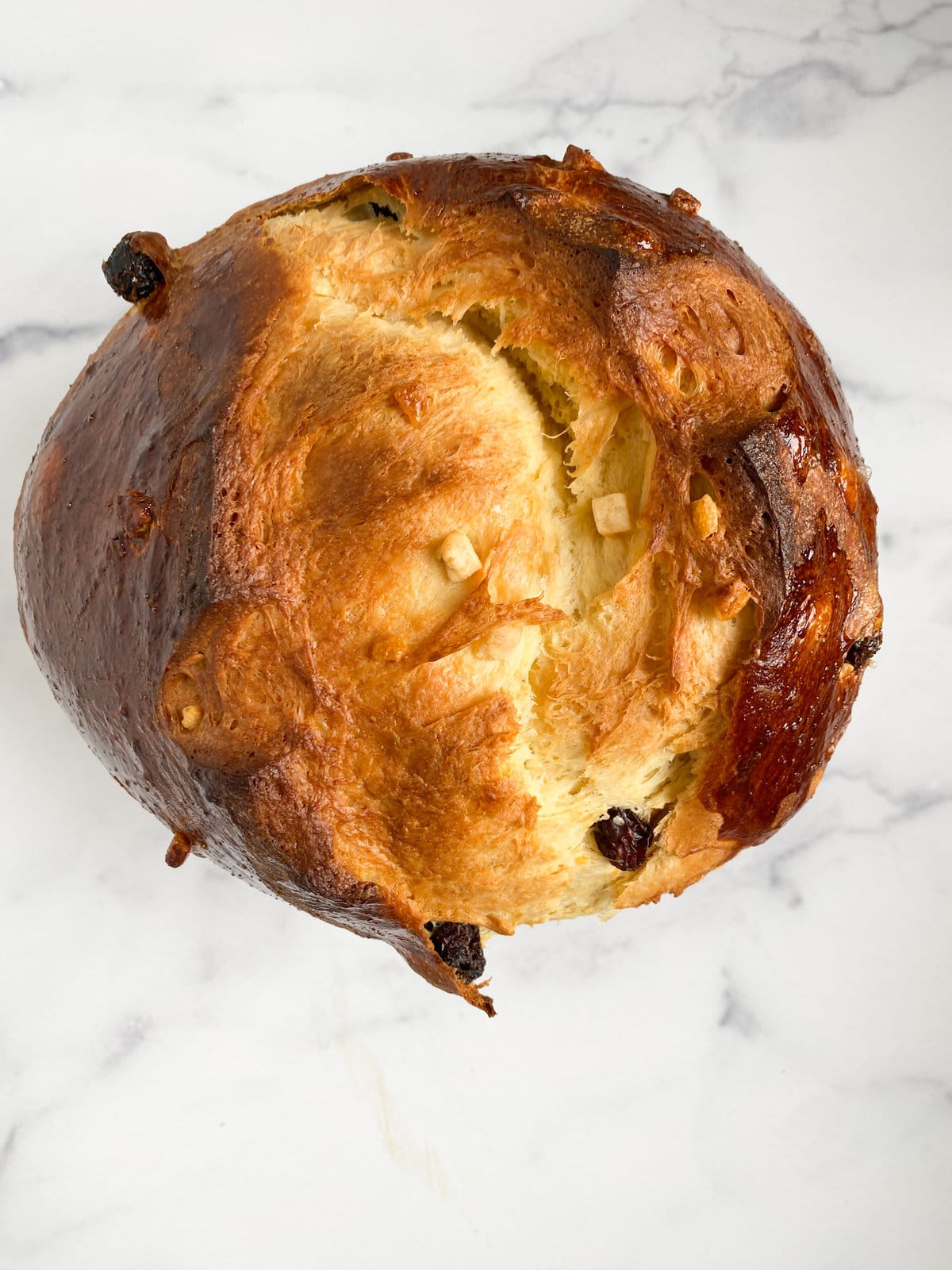
When finished baking, the Panettone bread or cake should be a deep brown color. It will sound hollow when tapped and reads 190°F at the center using a digital thermometer. It’s easy to under bake panettone since the top can brown quickly. Remove the panettone from the oven and cool completely.
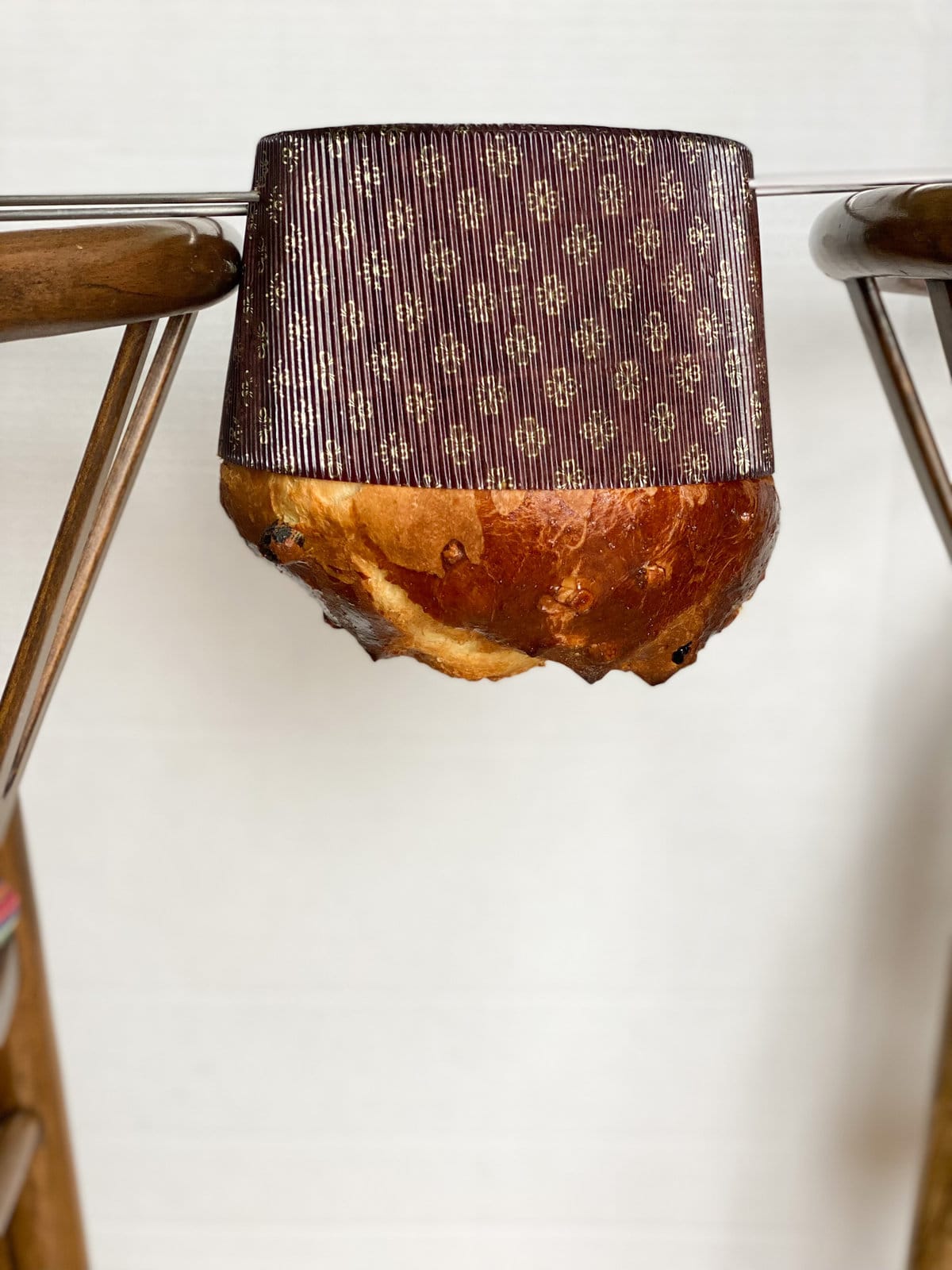
Rest. To cool the panettone- pierce each side with a bamboo skewer (or these panettone hangers), flip it over, and hang it between two tall jars. Hanging it upside down for a few hours prevents the panettone from caving.
You do not have to cool it upside down. You can cool it on a cooling rack.
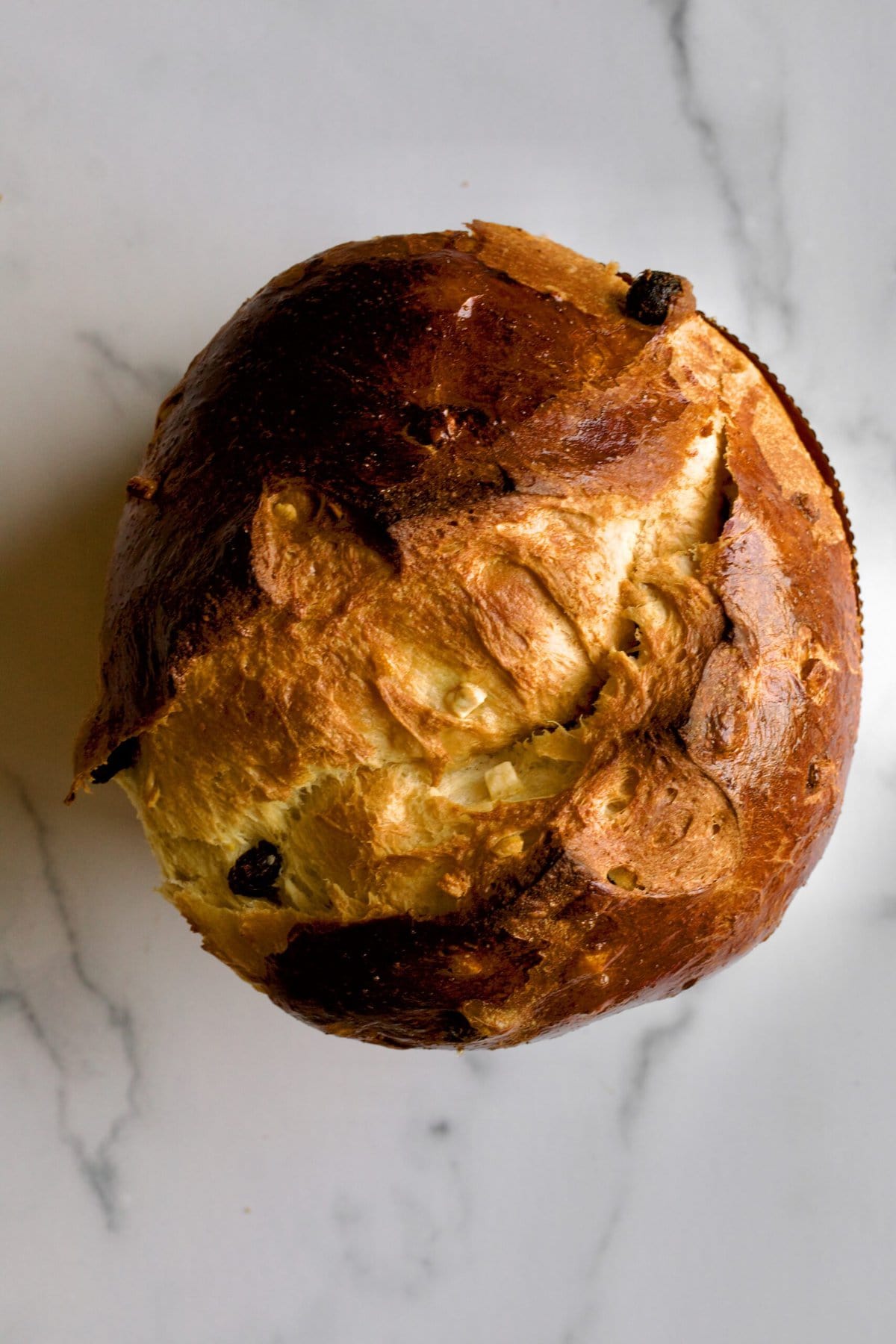
How to Fold the Panettone Dough
Here is a quick video on how to fold the panettone dough. In Italian, this process is called “metedo della pirlatura. This refers to working a dough according to the Pirlatura method or folding and shaping the dough.
Top Tips
- Use room temperature ingredients. Room temperature ingredients for baking give optimal results.
- Make sure you are working with yeast that is NOT expired, or you will do a lot of work for nothing ;).
- Follow the recipe exactly and be patient with the dough rising at the different stages. Find the warmest place in your home, or use a proofing oven.
- Use a kitchen scale and measure your ingredients.
- Hydrate the raisins in a bit of water, or they will be dry.
- Baker’s Secret: When the bread is cooling, poke it with two long metal or wooden skewers about 3-4 cm from the base. Then, let it rest upside down to cool completely. This will prevent the bread from collapsing while cooling.
Panettone Recipe FAQ
It is a bit of both! The Panettone cake recipe is a sweet bread that is baked in a round mold, which gives it a lighter-than-air fluffy texture. It is a sweet bread studded with candied fruit, raisins, and sometimes chocolate chips.
Traditional panettone is rich in raisins and candied fruit, with its classic tall dome shape. In contrast, pandoro is a simple and rich cake made with butter and eggs, with its distinctive star shape. Both are traditional Italian holiday cakes and taste delicious in their way.
Here is a baker’s secret to tall and fluffy panettone: When the bread is cooling, poke it with two long metal or wooden skewers about 3-4 cm from the base. Then, let it rest upside down to cool completely. This will prevent the bread from collapsing while cooling.
Yes, this panettone cake can be frozen whole or in slices. When stored in the freezer, homemade cakes are good for up to 1 month.
For best results, slice the cake first and wrap each slice individually. Pull out individual slices and reheat in a toaster oven.
When finished baking, the Panettone bread or cake should be a deep brown color. It will sound hollow when tapped and read 190°F at the center using a digital thermometer. It’s easy to underbake panettone since the top can brown quickly that is why I cook it at different temperatures and tent it will aluminum foil when baking.
To cool the panettone upside down,- pierce each side with a bamboo skewer, flip it over, and hang it between two jars. Hanging it upside down for a few hours prevents the panettone from caving.
Variations
A traditional panettone recipe is filled with candied oranges, raisins, currants, and orange zest. There are other classic panettone variations to try besides the classic dried fruit variety.
- Chocolate Chip – add chocolate chips (I love dark chocolate chips)
- Pistachio Cranberry Panettone – dried cranberries, pistachios, orange zest
- Black Forest Panettone – dried cherries, candied oranges, chocolate chip
- Rum-Soaked Raisins – use rum soaked raisins instead of soaking them in water
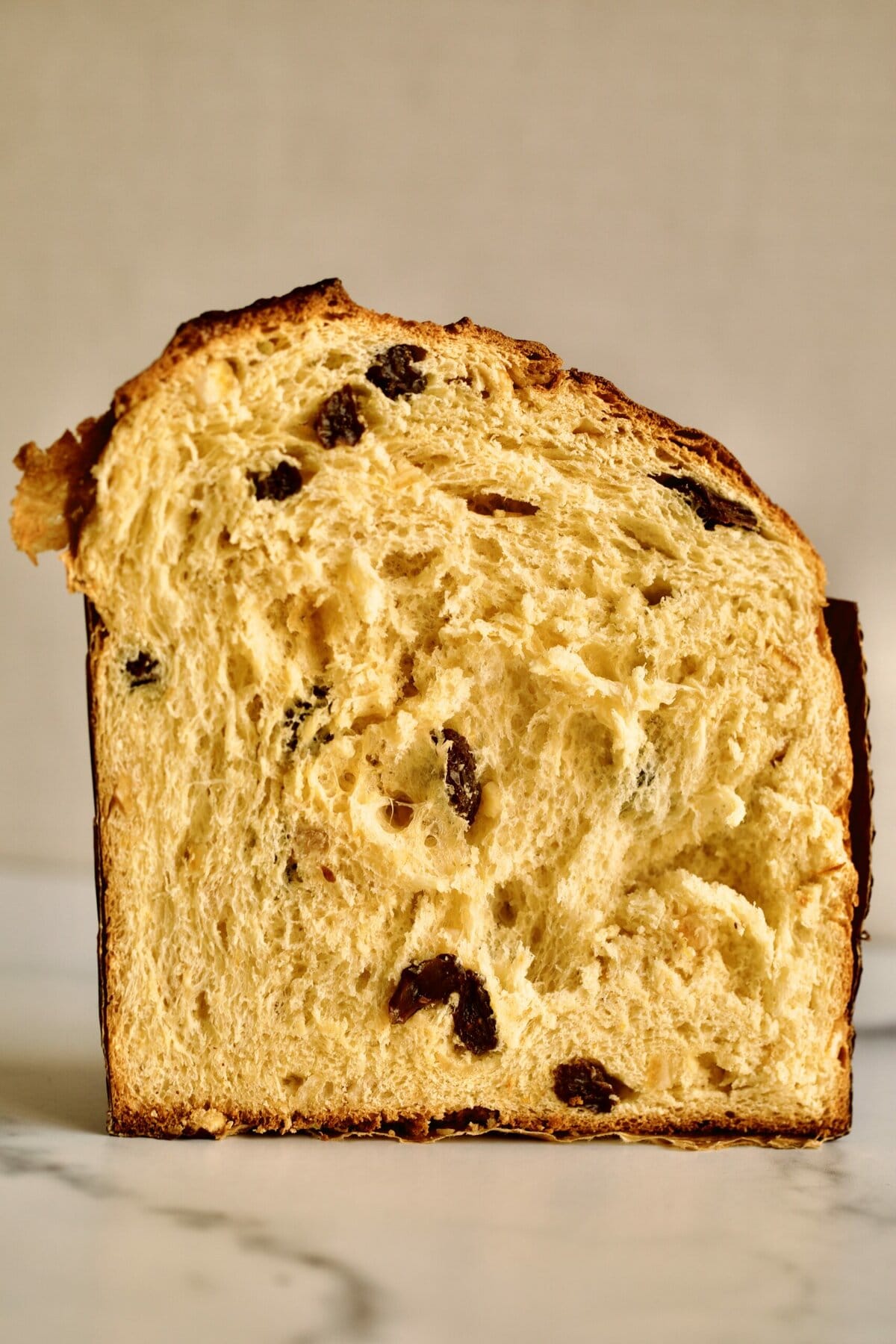
Equipment
- Panettone cake pan or or 8″ deep cake pan
- Panettone molds small (makes 2) Panettone Paper Pan Mold – Small – 500gr – 5-1/4″ x 3-3/4″ . Panettone Mold (makes 1) Large 1 Kg – 6-5/8″ x 4-5/16″
- Large mixing bowl
- Hand mixer or Stand mixer
- Optional: panettone holder for cooling (hanging the panettone upside down)
Serving Suggestions
Slice panettone into thick or thin wedges; that’s the traditional Italian way. If you baked it in a paper mold, slice right through it.
Panettone is more bread than cake. It’s slightly sweet. You eat it plain or serve a slice of panettone with a slather of butter to make it more decadent.
Whatever way you serve it, you are sure to love this tasty panettone recipe.
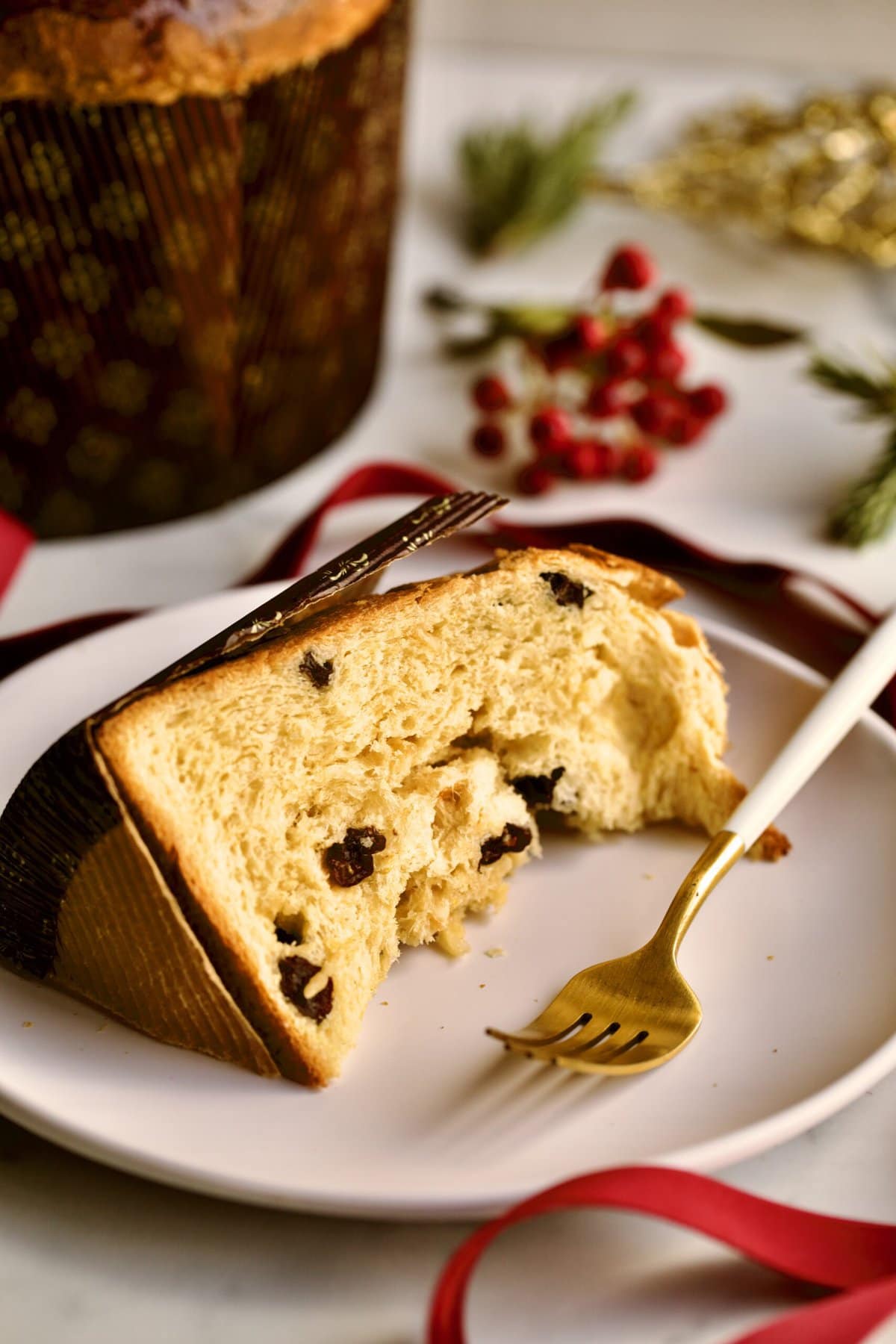
How to Store Italian Christmas Cake
To keep panettone fresh for up to one week at room temperature, wrap it in plastic wrap and then foil and place it in a resealable bag or airtight container.
What to do with Leftover Panettone
Use leftover panettone to make overnight french toast bake or simple french toast on a pan. I doubt you will have any leftovers after a couple of days.
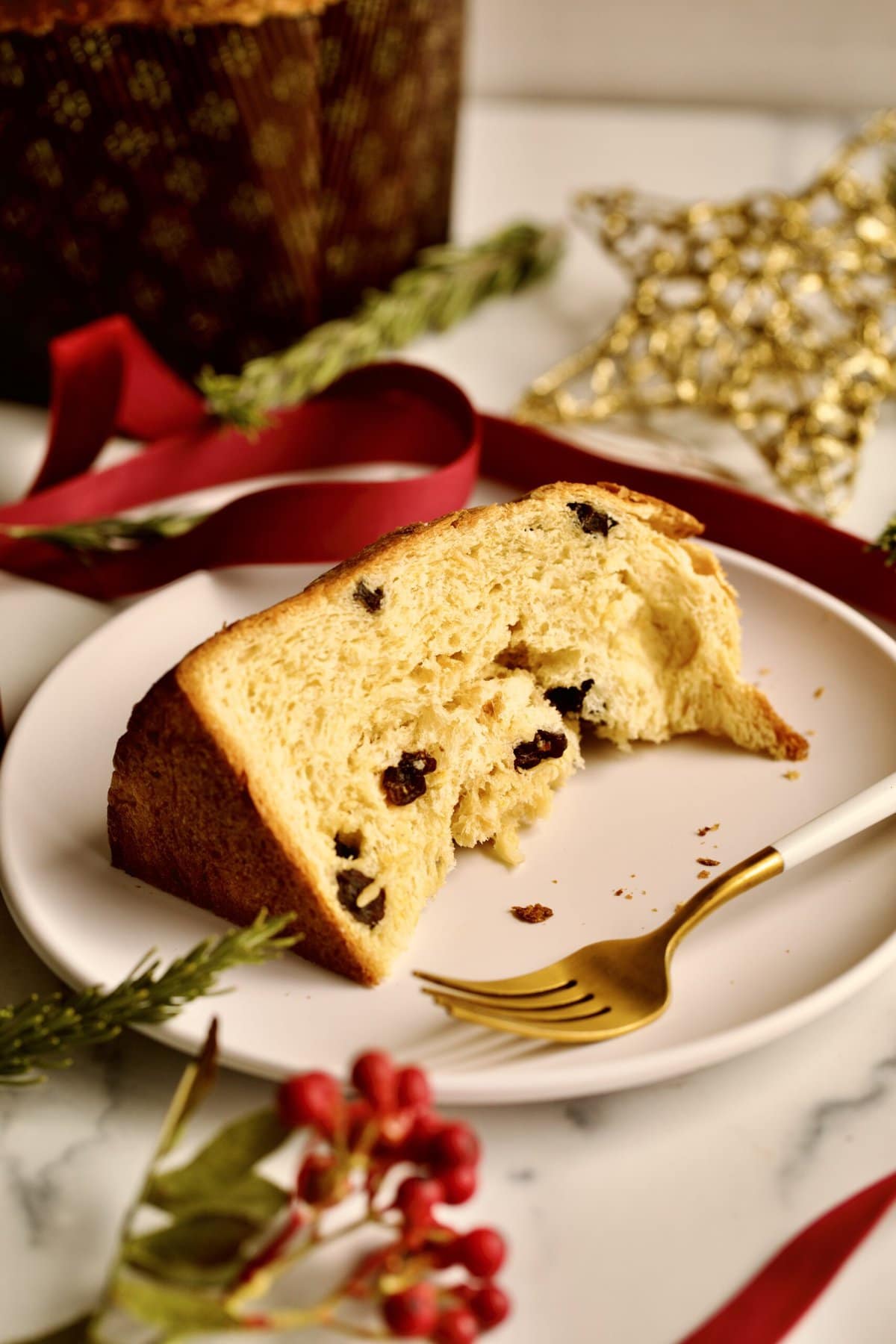
History of Traditional Panettone- Italian Christmas Cake
One popular legend states that its origin goes back to the late 1400s. During a luxurious Christmas banquet given by the Duke of Milan, the desert they were serving got burnt.
A kitchen boy (young cook), called Toni, came up with a rich brioche bread filled with raisins and candied fruit. The Duke loved it, and so the tradition of ‘Pane di Toni’ was born and later changed to “panettone” and become a bread of luxury.
In the Italian dictionary, the Italian word panettone derives from panetto, a small loaf cake. The augmentative suffix -one changes the meaning to “large cake.”
Whatever the origin or history of this authentic recipe, I am grateful we can enjoy it today. The Traditional Panettone Recipe (Italian Christmas Cake)is one of my favorite Christmas desserts. You will also love this Pandoro Christmas Tree Cake!
More delicious recipes
- Chiacchiere di Carnevale Recipe (Italian Fried Pastries)
- Bomboloni Recipe (Italian Donuts with Cream Filling)
- Zeppole Recipe (Easy Italian Donuts)
- Italian Easter Rice Pie Recipe (Pastiera di Riso)
- Heavenly Angel Food Cake with Blueberries
- Simple Italian Apple Cake (one bowl)
- Orange Olive Oil Cake Recipe (Italian)
- Poppy Seed Cake with Orange Almond Vanilla Glaze
💙 MADE THIS RECIPE AND LOVED IT? 💙 Please leave a ⭐️STAR rating and COMMENT below- I love connecting with you! Tag me with your creations on Instagram and find me on Pinterest.
Panettone Recipe

Ingredients
*Important: Use a kitchen scale and measure your ingredients in grams. It is more precise. Panettone molds small (makes 2) Panettone Paper Pan Mold – Small – 500gr – 5-1/4" x 3-3/4". Panettone Mold large (makes 1) Large 1 Kg – 6-5/8" x 4-5/16". I used the large.
The night before baking:
DOUGH STARTER:
- ¾ cup unbleached all-purpose flour, plus more if needed to feed the starter, 90g
- 1/16 teaspoon instant yeast, just a pinch
- ⅓ cup cool water, 80 g
MIX-INS
- ½½ tablespoon grated zest of about 1 lemon
- 1 tablespoon grated zest of about 1 orange
- 2 tablespoon honey
- 2 teaspoons vanilla extract
Baking day
FOR THE DOUGH
- All of the dough starter from above
- 3 cups all-purpose flour, divided, 384 g
- ½ cup lukewarm water, 135 g
- 1 tablespoon instant yeast
- ⅓ cup granulated sugar, 67 g
- 1 ¼ teaspoon salt, 8 g
- 5 egg yolks, room temperature
- 8 tablespoons butter, 113 g, softened
MIX-IN (see notes for variations)
- ½ cup raisins + 3 tablespoons water, 85 g
- ½ cup candied orange peel, finely chopped, 85 g
TOPPING
- 1 egg, beaten (egg wash)
- 1 pat butter, for topping
- Pearl sugar
Instructions
- The night before baking
- Dough Starter: Combine the starter ingredients in a medium-sized mixing bowl, mix with a fork until a shaggy mixture. Cover, and allow it to rest in a warm place for 8-12 hours. This is called your biga- a type of pre-fermentation. You can also use a sourdough starter if you have some and skip this step (use 190 g of the starter if you have it already).
- Prepare Mix-Ins: In a small bowl, combine the honey, vanilla extract, orange peel, and lemon + orange zest. Mix to combine. Cover and set aside. In a separate bowl, combine raisins with water. Cover and set aside. This step makes sure the raisins stay moist during baking. Let them rest overnight.
- Baking day
- Dough Part 1 and 1st rise: In a stand mixer with a dough hook, combine the dough starter (biga), half of the flour, and all of the water and yeast. Mix until combined, and knead with the dough hook (or by hand) for about 5 minutes. Cover with plastic wrap and let rise for 1 hour in a warm place. The dough should triple in size.
- Dough Part 2: After the dough rises for 1 hr, add the rest of the flour and mix to combine. The dough will look shaggy and crumbly. Let rest for 10 minutes.
- Meanwhile, beat the egg yolks, salt, and sugar in a medium bowl until fluffy and creamy, about 5 minutes. Add the honey, candied orange, and zest mixture to the beaten eggs and stir until combined.
- Slowly add the egg and orange mixture to the dough. Mix with a dough hook until the dough is sticky and uniform; mix with a dough hook (or by hand) for about 5 minutes. The dough will be sticky, and it will take several minutes to come together, about 10 minutes of kneading!
- Add the butter to the dough, small bits at a time, mixing after each addition. Mix dough with a dough hook (or by hand) until a smooth dough forms (still sticky). After the butter is incorporated, add the raisins (remove excess water, if any). Gently mix until the raisins are incorporated into the dough. Make the dough into a ball. Move the dough to a clean and greased bowl.
- Dough Rise 2: Cover the dough, and let it rise for 1 to 2 hours or until it's puffy or proofed and doubled in size. Gently deflate the dough.
- Fold Dough (see the video in this post for a visual view). Move to a greased baking sheet or countertop (do not add extra flour use greased hands to work with dough). Start clockwise- by taking the top corner of the dough (12 o'clock position), pinch a corner of the dough and lift it up and let the dough stretch by lifting your hands up. Fold the stretched dough back on itself (6 pm location). Turn the dough clockwise so (your 12 o'clock position is now the 3 pm location). Repeat the same process of stretching and folding the dough onto itself 3 times total. This fast process takes about 1 minute from start to finish.
- Let the dough rest for 10-15 minutes and repeat the folding process 2 more times with these exact directions of stretching and folding.
- Shape Dough. Bring the corners in toward the center to form a ball, and pinch the loose ends together. Cup your hands around the dough to round the ball. Place it in a well-buttered or sprayed panettone pan, mold paper, or other straight-sided, tall 1 1/2- to 2-quart pan.
- Dough Rise 3: Let the dough rise in a warm place until it reaches over the rim of the mold, about 1 1/2- 2 hours (time varies depending on humidity and temperature). You want the dough just at the rim or slightly above the mold. When the rise is complete, brush the top with egg wash. Make cross cuts on the panettone with a sharp knife, and put a small pat of butter in the center of the cake. Sprinkle with the desired amount of pearl sugar (optional).
- Bake: Bake the cake in a preheated 375°F oven for 10 minutes; then reduce the heat to 350°F and bake for about 30-35 minutes, tenting with aluminum foil if the top of the panettone appears to be browning too fast.
- When finished baking, the Panettone bread or cake should be a deep brown color. It will sound hollow when tapped and will read 190°F at the center using a digital thermometer. It’s easy to underbake panettone since the top can brown quickly. Remove the panettone from the oven and cool completely.
- Rest: To cool the panettone- pierce each side with a bamboo skewer (or these panettone hangers), flip it over, and hang it between two tall jars. Hanging it upside down for a few hours prevents the panettone from caving in on itself. You do not have to cool it upside down. You can cool it on a cooling rack.
- Storage: Store at room temperature, well-wrapped, for up to a week; freeze for longer storage.
Notes
- Use room temperature ingredients. Room temperature ingredients for baking give optimal results.
- Make sure you are working with yeast that is NOT expired, or you will do a lot of work for nothing ;).
- Follow the recipe exactly and be patient with the dough rising at the different stages. Find the warmest place in your home, or use a proofing oven.
- Use a kitchen scale and measure your ingredients.
- Hydrate the raisins in a bit of water, or they will be dry.
- Baker’s Secret: When the bread is cooling poke it with two long metal or wooden skewers about 3-4 cm from the base. Then, let it rest upside down to cool completely. This will prevent the bread from collapsing while cooling.
- Chocolate Chip – add chocolate chips (I love dark chocolate chips)
- Pistachio Cranberry Panettone – dried cranberries, pistachios, orange zest
- Black Forest Panettone – dried cherries, candied orange, chocolate chip
- Rum-Soaked Raisins – use rum soaked raisins instead of soaking them in water
Nutrition
Nutrition information is automatically calculated, so should only be used as an approximation.
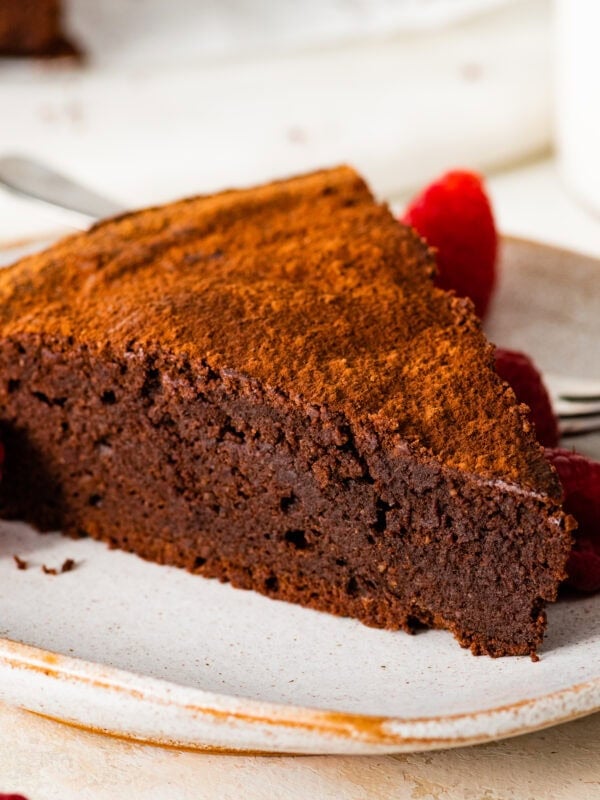
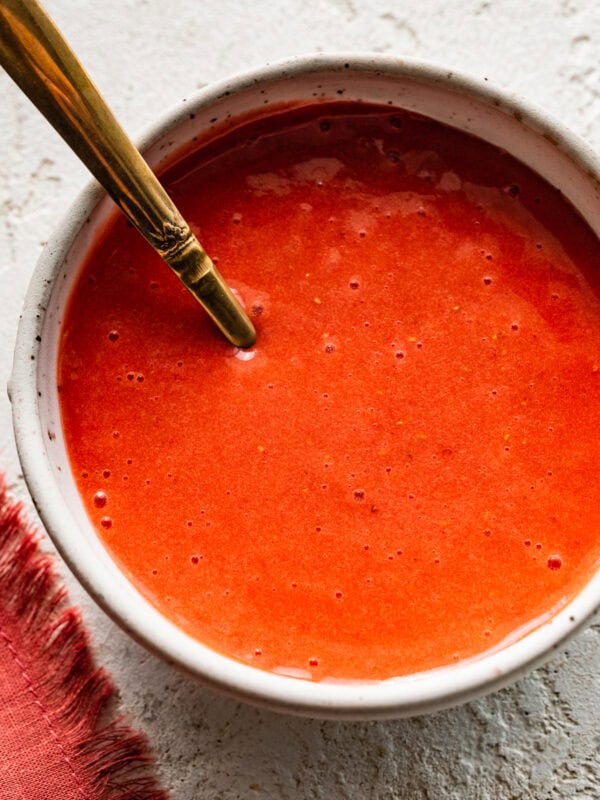
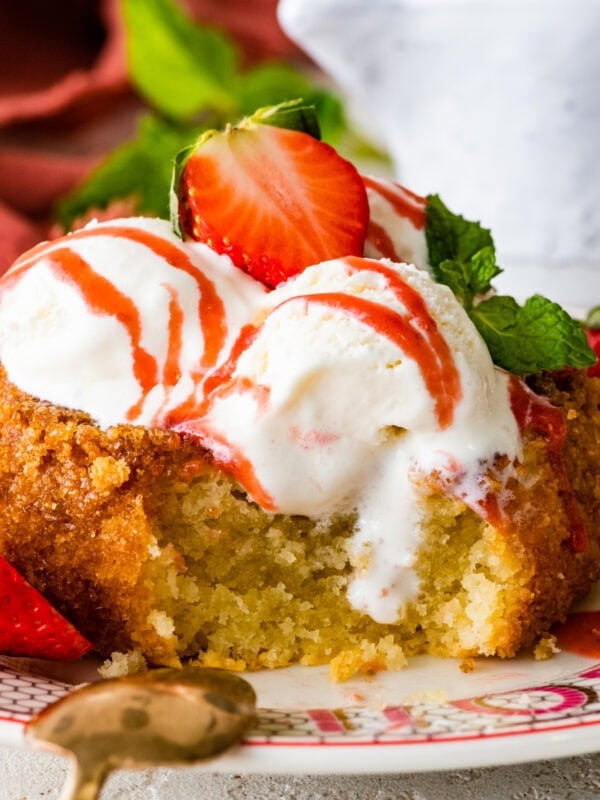
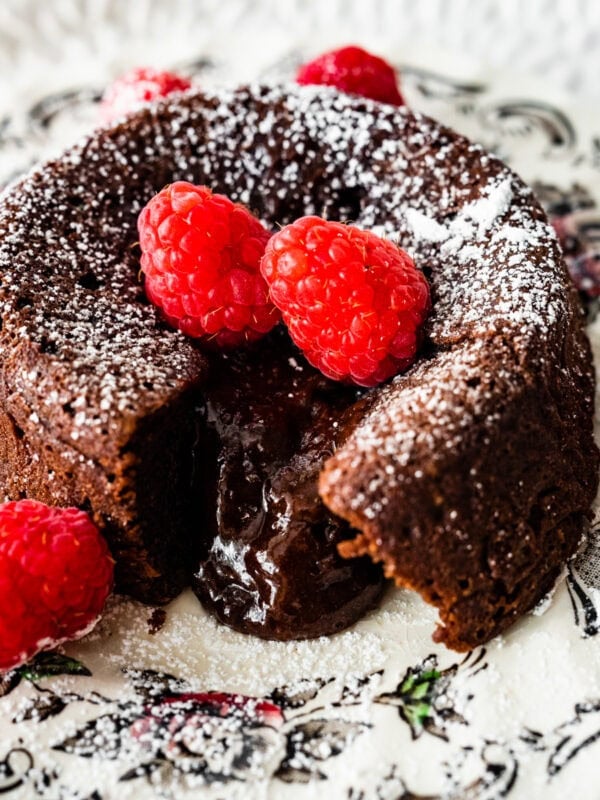




Elena, THANK YOU so much for sharing this wonderful recipe! I made this panettone for Christmas for my husband Stefano for the first time. We enjoyed it Christmas morning with coffee, and my husband said it was the best panettone he’d ever had (his family always bought panettone in stores in Italy). I used the Caputo Flour Manitoba Oro Type “0” and their active yeast, which worked perfectly for this recipe. I wish I could share my pictures with you. Thanks again, and Merry Christmas!!
If I wanted to use fresh yeast, what quantity should I use please?
Here is the conversion. I don’t normally use fresh yeast since I don’t have available where we live: To convert from fresh yeast to active dry yeast, multiply the fresh quantity by 0.4. Active dry yeast must be hydrated in warm water before being incorporated into a dough. To convert from fresh yeast to instant dry yeast, multiply the fresh quantity by 0.33.
Thank you Elena. In the end I used about 1g fresh yeast for the Dough Starter which is almost on par with the 0.33 you stated but when it came to the dough itself I reduced what would have been 45g to 35-37g and this worked so well. I will probably reduce the amount of orange peel next time but that’s nothing to do with your recipe and more to do with me using orange peel from seville oranges which were leftovers from making marmalade. They are a very intense flavour. Even though my orange was a tad overpowering, it was a fabulous panettone and I’m so pleased I finally got around to making my own. I have always thought I didn’t really like it as the shop produced ones are incredibly dry. I used the leftovers to make a panettone bread and butter pudding using Gary Rhodes recipe for bread and butter pudding. It was amazing. Thank you so much for sharing this recipe.
I am so happy this recipe turned out so great for you and you are able to make the adjustments needed for your liking. It is a wonderful recipe to make time and time again. You are most welcome. Enjoy many other delicious recipes on my website. You may like our Crusty Bread and Italian Pear Cake!
Hi!
I am planning on making this for Christmas. I think I want to try the black forest version. Have you made it before? Any tips? I’m also thinking I would want to soak the cherries and still make the zest mixture. Does that sound about right?
Yes, I would do all that you mentioned! make sure to drain any excess moisture when you soak the cherries (if you decide to do that part). Enjoy!